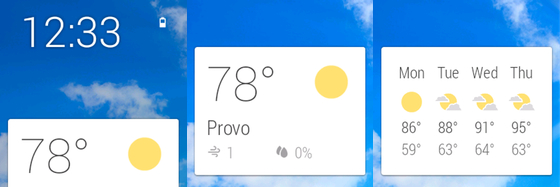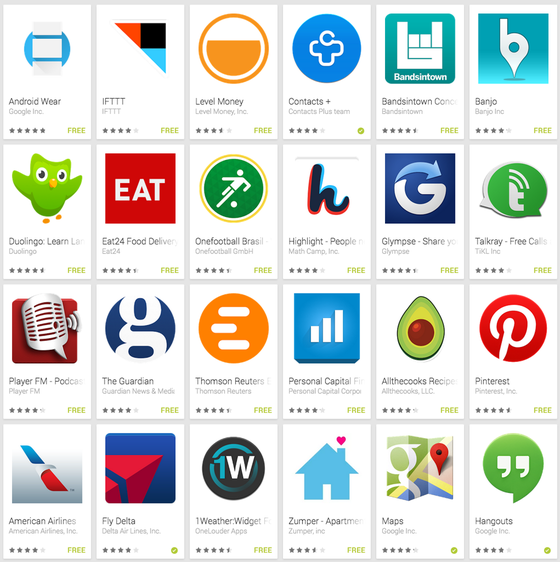I’ve been using an Android Wear device – the Samsung Galaxy Live – since I picked it up at I/O last week. I’ve tried a number of other smartwatches before now, and it’s interesting to see the differences. As it’s currently constituted, I see three flaws with Google Wear, two of which seem to be pretty fundamental, and one of which should be fixed soon:
Cards are a bad UI for small screens
Cards make a ton of sense on smartphones and tablets and on the web, where they provide useful visual separation between discrete chunks of information, and they work well on Twitter.com, in Google Now on smartphones, and elsewhere. But on a space-constrained screen they really don’t work because they’re a terribly inefficient use of screen real estate. There are several different layers of information in Android Wear, as shown in this triptych:
The first screen is what you see before you interact with a card – the card stays in the bottom half, and takes up just a third of the screen. The amount of information presented is extremely limited. If I then interact with the card, I get the middle screen, which is slightly richer but still takes up only half the pixels on the display. If I then swipe, I get even more information as shown on the right. But the card still only takes up half the screen. Compare this with the Galaxy Gear 2, which (though not a paragon of great UI) uses the whole screen to display notifications. This is a minor annoyance with the weather card from Google Now, but it’s really annoying when a notification comes in about a new email, and just a tiny amount of the email shows by default – I almost always have to tap on the small card to make it big enough to have a real sense of what it’s about. The “glanceability” factor just isn’t there.
The cards UI, with its limited use of the screen space, and the rest given over to a background that really adds nothing, is just not a good fit for such a small screen. It’s a great example of the problem with applying a single design language, essentially without modifications, to multiple form factors. It’s a problem that Microsoft has struggled with too in the form of Windows 8, and one that Apple so far seems to have managed to avoid in providing useful integration between iOS and OS X without taking things too far.
Google Now is still too much just in case and not enough just in time
One of the selling points of Android Wear is its tight integration with Google Now, which has been available for quite some time on smartphones but is only now becoming available on smartwatches. The theory here is good: Google Now is supposed to surface information just when it’s likely to be useful to the user, but the watch allows it to be presented in a much more immediate way than were the user to have to dig through their phone to find it. But the problem is that Google Now, in my experience, still presents information much more on a “just in case” basis than a “just in time” basis, and the stuff that’s “just in time” is often not all that useful.
This past week, Google Now has shown me a handful of categories of notifications:
- World Cup updates – there’s been a constant card on my smartphone showing the latest scores and upcoming fixtures. It’s somewhat useful to have it there to look at when I’m interested, but I could get the same information by going into the ESPN SportsCenter app or FIFA’s own app if I happen to be interested in it right now. In the meantime, it’s shown every time I open Google Now, and frequently pops up on the watch too.
- Baseball updates – Google Now knows I’m a Yankees fan, and shows me updates on the score from active games. That’s somewhat useful, but it tends to update relatively infrequently (a problem with the World Cup scores too). If I really care what the score is right now, it’s not very useful. And in the meantime, the watch is constantly showing me the time of the next game as one of my cards.
- Traffic times to various places – the most egregious example of this is a long-standing problem I have with Google Now: it thinks I work at the gym, because it’s the only place I “commute” to most weekdays. While that’s flattering, it’s wrong, and Google Now doesn’t seem to be able to handle the fact that my work and home are in the same place. But it’s also been showing me times to places I have recently searched for, even after I’ve been there. Knowing it’s 10 minutes to the nearest Chipotle is not very helpful when I’ve just finished a delicious burrito at that very spot.
- Weather – this card is up permanently, but for the reasons above the way the information is displayed is not all that useful.
Some of these cards are sometimes useful, but it’s the exception rather than the rule, and the inability to order cards in the way I want, having the thing I care most about uppermost and the other stuff don’t below, is really frustrating. Either I can swipe cards away, in which case who knows when they’ll show up again, or I can continue swiping through the ones I don’t care about as much (but want to keep on there somewhere) to get to the ones I care about more. Perhaps Google will learn what I care about most eventually, but I feel like I should be able to just tell Google Now what I want rather than having to “train” it over time (this is one of the best features of Microsoft’s Cortana, by the way – the Notebook feature that allows you to manually review these settings). While a minor frustration on the smartphone, it’s really annoying on a watch where you can only see one card at a time.
For the most part, though, the fundamental issue is that Google Now rarely surfaces something that’s really relevant right now, and if I’m going to give over that spot on my wrist to something, it’d better be really important right this minute. And Google Now mostly fails to deliver on that. I have heard from some power users that they find it useful, but I would think many people simply won’t get enough value from this feature to be a useful differentiator for Google. (Note that I travel a great deal, often have multiple meetings back to back, and I live in Google Apps both in my personal and work life – the problem here isn’t that I’m not the target user).
Apps just don’t support it yet
Given that Google Now isn’t really cutting it for me, the notifications from other apps had better be pretty good. But unfortunately, the notifications I’m getting right now are hampered both by the card UI I discussed earlier and by the fact that most apps are just passing through generic Android notifications for now rather than Wear-specific notifications. With the release of the Android Wear app and the new version of Google Play Services, Google has published a new page to the Play Store showcasing apps that work with Android Wear:
It’s a short list – that’s all of them in that screenshot there. Three of the 24 are from Google itself, while several others are those used in demos at the two events Google has held about Android Wear. There has been very little work yet by developers to really take advantage of Android Wear yet, suggesting a reluctance to invest in the product before units were really in the market, despite the availability of developer tools for several months. Now that developers actually have smartwatches in hand, that may improve, but until it does many of the notifications apps are providing in Android are just not that useful on the small screen. Anything that stacks notifications is particularly poor, again in contrast to the Galaxy Gear 2 approach which allows scrolling through multiple notifications from the same app.
This should get fixed, but I do have the sense that Motorola might benefit from being a little later to market now. Anyone who has the current Android Wear experience as their first impression of the platform may well be put off, and whatever the reason for the later shipping of the Moto 360, its eventual users may well have a better experience than early Gear Live and G Watch users. Unfortunately, the cards UI and Google Now aren’t going to be fixed as easily, and they may let Android Wear down longer term.
